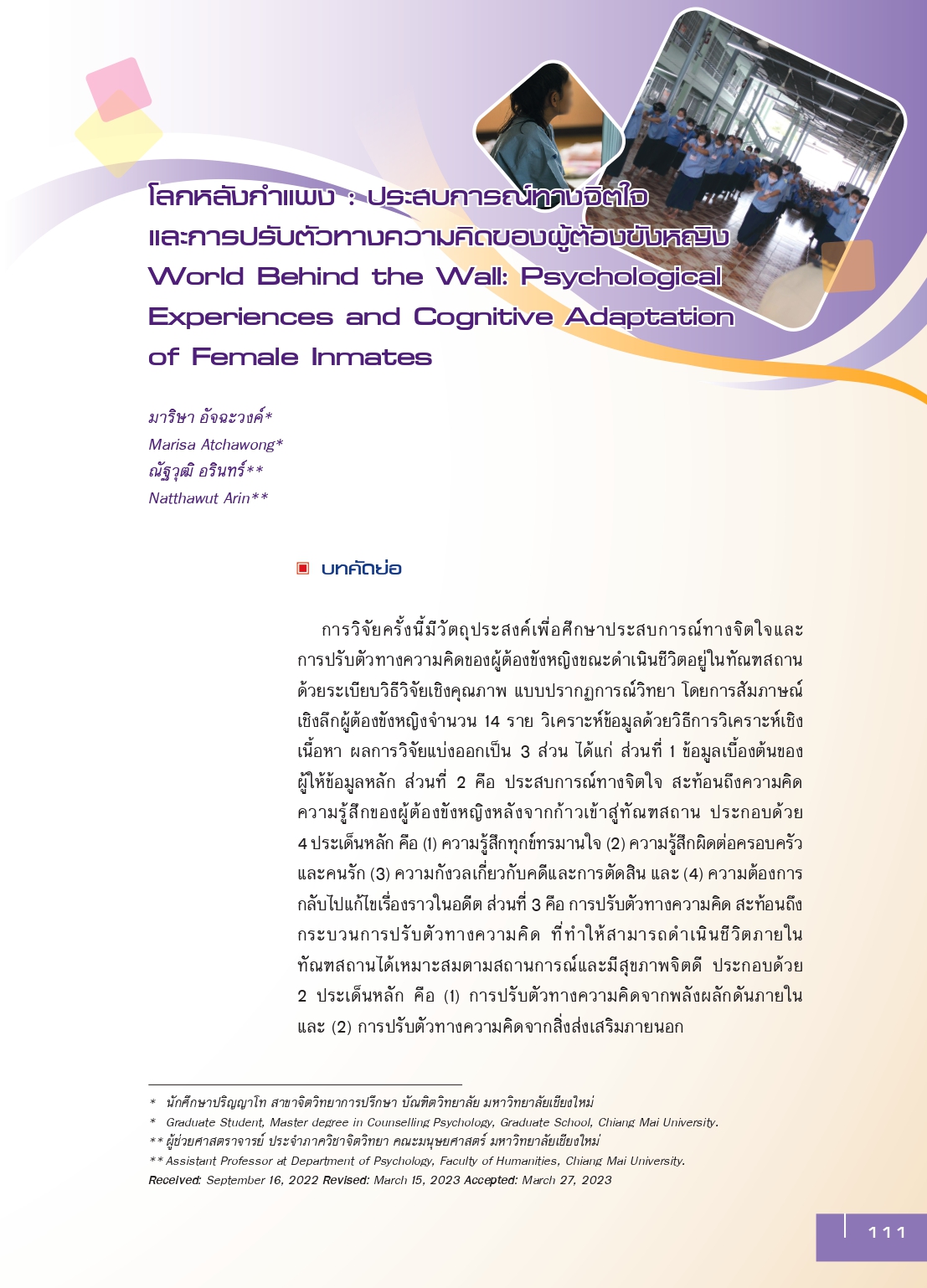โลกหลังกำแพง : ประสบการณ์ทางจิตใจและการปรับตัวทางความคิดของผู้ต้องขังหญิง
Main Article Content
บทคัดย่อ
การวิจัยครั้งนี้มีวัตถุประสงค์เพื่อศึกษาประสบการณ์ทางจิตใจและการปรับตัวทางความคิดของผู้ต้องขังหญิงขณะดำเนินชีวิตอยู่ในทัณฑสถาน ด้วยระเบียบวิธีวิจัยเชิงคุณภาพ แบบปรากฏการณ์วิทยา โดยกาiสัมภาษณ์เชิงลึกผู้ต้องขังหญิงจำนวน 14 ราย วิเคราะห์ข้อมูลด้วยวิธีการวิเคราะห์เชิงเนื้อหา ผลการวิจัยแบ่งออกเป็น 3 ส่วน ได้แก่ ส่วนที่ 1 ข้อมูลเบื้องต้นของผู้ให้ข้อมูลหลัก ส่วนที่ 2 คือ ประสบการณ์ทางจิตใจ สะท้อนถึงความคิด ความรู้สึกของผู้ต้องขังหญิงหลังจากก้าวเข้าสู่ทัณฑสถาน ประกอบด้วย 4 ประเด็นหลัก คือ (1) ความรู้สึกทุกข์ทรมานใจ (2) ความรู้สึกผิดต่อครอบครัวและคนรัก (3) ความกังวลเกี่ยวกับคดีและการตัดสิน และ (4) ความต้องการกลับไปแก้ไขเรื่องราวในอดีต ส่วนที่ 3 คือ การปรับตัวทางความคิด สะท้อนถึงกระบวนการปรับตัวทางความคิด ที่ทำให้สามารถดำเนินชีวิตภายในทัณฑสถานได้เหมาะสมตามสถานการณ์และมีสุขภาพจิตดี ประกอบด้วย 2 ประเด็นหลัก คือ (1) การปรับตัวทางความคิดจากพลังผลักดันภายใน และ (2) การปรับตัวทางความคิดจากสิ่งส่งเสริมภายนอก
ผลการวิจัย นำไปสู่ข้อเสนอแนะส่งเสริมกระบวนการเยียวยาและฟื้นฟูทางจิตใจในกลุ่มผู้ต้องขังหญิง ด้วยกระบวนการทางจิตวิทยา เพื่อช่วยให้ผู้ต้องขัง เกิดการพิจารณาตน การตระหนักรู้ต่อตนเอง รับรู้คุณค่าภายในตนเอง พบเจอความหวัง มองโลกในแง่ดี มีสติ ตลอดจนค้นพบกลวิธีการเผชิญหน้ากับปัญหาได้อย่างเหมาะสม จะทำให้ผู้ต้องขังหญิงมีสุขภาพจิตที่ดี
Article Details

อนุญาตภายใต้เงื่อนไข Creative Commons Attribution-NonCommercial-NoDerivatives 4.0 International License.
ต้นฉบับที่ได้รับการตีพิมพ์ในวารสาร เป็นลิขสิทธิ์ของวารสารกระบวนการยุติธรรม แต่ความคิดเห็นที่ปรากฏในเนื้อหาของบทความในวารสารกระบวนการยุติธรรม ถือเป็นความรับผิดชอบของผู้เขียนแต่เพียงผู้เดียว
เอกสารอ้างอิง
กรมราชทัณฑ์. (2563). สถิติผู้ต้องขังของประเทศไทย. ค้นเมื่อ 10 มีนาคม 2563, จาก http://www.correct.go.th.
กฤตยา อาชวนิจกุล และกุลภา วจนสาระ. (2558). ผู้ต้องขังหญิง : สถานการณ์และข้อเสนอเชิงนโยบาย. นครปฐม: สมาคมนักวิจัยประชากรและสังคม สถาบันวิจัยประชากรและสังคม มหาวิทยาลัยมหิดล.
ขนิษฐา แสนใจรักษ์. (2552). ในชั่ววูบของการฆ่าตัวตาย: การศึกษาเชิงปรากฏการณ์วิทยาในผู้ที่ผ่านประสบการณ์การพยายามฆ่าตัวตาย. วิทยานิพนธ์ปริญญาศิลปศาสตร์มหาบัณฑิต. จุฬาลงกรณ์มหาวิทยาลัย.
คาลอส บุญสุภา, มฤษฎ์ แก้วจินดา และวรางคณา โสมะนันทน์. (2563). การเห็นคุณค่าในตนเองของนิสิตในมหาวิทยาลัยในกำกับของรัฐ. วารสารเกษมบัณฑิต, 22(2), 43-53.
ชาตินวภพ สมกำลัง และนิรนาท แสนสา. (2560). ประสบการณ์การก้าวผ่านภาวะวิกฤตของผู้ต้องโทษประหารชีวิตในเรือนจำบางขวาง. วารสารศึกษาศาสตร์
มสธ., 10(2), 273-290.
ฐิติมาพร จุลกิ่ง. (2560). สิทธิในการดำรงชีวิตของผู้ต้องขังหญิง. วิทยานิพนธ์นิติศาสตรมหาบัณฑิต. มหาวิทยาลัยธุรกิจบัณฑิตย์.
ทัณฑสถานหญิงเชียงใหม่. (2557). วิสัยทัศน์ทัณฑสถานหญิง. ค้นเมื่อ 10 เมษายน 2564, จาก http://www.correct.go.th.
ทัณฑสถานหญิงชลบุรี, (2548). วิสัยทัศน์ทัณฑสถานหญิง. ค้นเมื่อ 10 เมษายน 2564, จาก http://www.correct.go.th.
ธนพัฒน์ เฉลิมรัตน์ และชิต จุลราช. (2563). การนำหลักพุทธธรรมมาประยุกต์ใช้ในการปรับสภาวะทางอารมณ์: ศึกษากรณีผู้ต้องขังชายเรือนจำจังหวัดเลย. วารสาร มจร. เลย ปริทัศน์, 1(1), 29-39.
เบญญพร บรรณสาร และลินจง โปธิบาล. (2559). ความสิ้นหวังของผู้รอดชีวิตจากมะเร็ง. วารสารการพยาบาลจิตเวชและสุขภาพจิต, 32(2), 1-12.
ณัฐวุฒิ ยอดระบำ. (2549). มูลเหตุจูงใจในการกระทำผิดซ้ำคดีเกี่ยวกับทรัพย์: ศึกษาเฉพาะกรณี เรือนจำจังหวัด นนทบุรี. วิทยานิพนธ์ปริญญาศิลปศาสตรมหาบัณฑิต. มหาวิทยาลัยธรรมศาสตร์.
ดวงตา ไกรภัสสร์พงษ์. (2550). สุขภาพจิตและกลไกทางจิตของผู้ต้องขังและนักโทษไทย. วารสารสุขภาพจิตแห่งประเทศไทย,15(2), 79-92.
ต้นสาย แก้วสว่าง, ศิริรัตน์ เอี่ยมประไพ และภาสกร คุ้มศิริ. (2565). กลไกทางจิต: บทความปริทัศน์. วารสารจิตวิทยา มหาวิทยาลัยเกษมบัณฑิต, 12(1), 149-164.
ธัมมลักขณา ภิกษุณี. (2559). พุทธวิธีรับมือกับความกลัว. Veridian E-Journal,Silpakorn University, 9(3), 483-488.
พระวีระพจน์ ชาครธมฺโม (ผลจันทร์). (2562). สติในกระบวนการสานเสวนานำพาสันติสุขสู่ชายแดนภาคใต้. วารสารวิชาการสถาบันพัฒนาพระวิทยากร, 2(2), 19-28.
พิสมัย รัตนโรจน์สกุล. (2554). สร้างชีวิตใหม่ในเรือนจำ. วารสารวิชาการ มหาวิทยาลัยหอการค้าไทย, 31(3), 40-53.
พรรณวดี คำไชยวงค์. (2564). การแปลงเปลี่ยนพฤติกรรมและความสำเร็จในการกลับคืนสู่สังคม: จากนักโทษสู่นักกีฬาอาชีพ. วารสารสันติศึกษาปริทรรศน์ มจร, 9(2), 534-547.
เพชรไทย ขุนทองจันทร์.(2559). เรื่องเล่าจากคนผ่านคุก กรณีศึกษา ผู้พักโทษและลดโทษจากสำนักงานคุมประพฤติกรุงเทพมหานครประจำศาลจังหวัดตลิ่งขัน. วิทยานิพนธ์ปริญญาศิลปศาสตรมหาบัณฑิต. มหาวิทยาลัยศิลปากร.
ภาวดี ทองเผือก. (2547). ผลของการใช้โปรแกรมส่งเสริมการรับรู้ความสามารถของตนเองที่เน้นการสนับสนุนจากสามีต่อการปรับตัวด้านบทบาทหน้าที่การเป็นมารดาในหญิงตั้งครรภ์วัยรุ่นครรภ์แรก. วิทยานิพนธ์พยาบาลศาสตรมหาบัณฑิต. จุฬาลงกรณ์มหาวิทยาลัย.
เริงชัย หมื่นชนะ. (2558). ระบบและทฤษฎีพุทธจิตวิทยา. วารสารมหาจุฬาวิชาการ, 2(1), 63-78.
วีรยุทธ แสนพงค์ และจิระสุข สุขสวัสดิ์. (2561). ประสบการณ์การปรับตัวของผู้ต้องขังสูงอายุในเรือนจำกลางบางขวาง. วารสารอิเล็กทรอนิกส์การเรียนรู้ทางไกลเชิงนวัตกรรม, 8(1), 191-204.
ศิริพร แทนสุวรรณ์ และวรรณนะ หนูหมื่น. (2561). นัยสำคัญในเรื่องเล่า ความเจ็บปวด “ฉันคือเอรี่ กับประสบการณ์ข้ามแดน. วารสารวิทยบริการ มหาวิทยาลัยสงขลานครินทร์, 29(2), 172-183.
สมภพ แจ่มจันทร์. (2550). ประสบการณ์ทางจิตใจของผู้ต้องขังหญิงคดีฆาตกรรมในทัณฑสถานหญิงเชียงใหม่. วิทยานิพนธ์ปริญญาศิลปศาสตรมหาบัณฑิต. จุฬาลงกรณ์มหาวิทยาลัย.
สถาบันเพื่อการยุติธรรมแห่งประเทศไทย. (2561). รายงานการวิจัย เรื่องเพศภาวะและเส้นทางสู่เรือนจำ:การศึกษาเรื่องเล่าของผู้ต้องขังหญิงและผู้ต้องขังชายคดียาเสพติดในประเทศไทย. กรุงเทพฯ: สถาบันเพื่อการยุติธรรมแห่งประเทศไทย (องค์การมหาชน).
อุทยา นาคเจริญ. (2547). สภาวะสุขภาพจิตของนักโทษคดีความผิดต่อชีวิตและร่างกาย. วารสารสถาบันกัลยาณ์ราชนครินทร์, 1(1), 1-78.
Abukurdi, S., Jahromi, M. N., Hoseini, S., & Nikroo, M. (2012). The Relationship between resilience and mental disorders among young criminals at Shiraz Central prison. Scientific Journal of Krudistan University of MedicalSciences, 17(3), 43-50.
Bandura, A. (1986). Social foundations of thought and action: A social cognitive theory. New Jersey: Prentice-Hall.
Besemer, S., Farrington, D. P., & Bijleveld, C. (2017). Labeling and intergenerational transmission of crime: The interaction between criminal justice intervention and a convicted parent. PLOS ONE, 12(3), 1-16.
Bonta, J., & Gendreau, P. (1990). Reexamining the cruel and unusual punishment of prison life. Law and Human Behavior, 14(4), 347–372.
Carver, C. S., & Scheier, M. F. (1998). On the self-regulation of behavior. N.p.: Cambridge University.
Caron, P. H. (2010). Self-Reported Physical Health of Inmates: Impact of Incarceration and Relation to Optimism. Journal of Correctional Health Care, 16(2), 106-116.
Campbell, W. K., Rudich, E. A., & Sedikides, C. (2002). Narcissism, Self-Esteem, and the positivity of Self-Views: two portraits of Self-
Love. Personality and Social Psychology Bulletin, 28(3), 358–368.
Crist, J. D., & Tanner, C. A. (2003). Interpretation/analysis methods in hermeneutic interpretive phenomenology. Nursing Research, 52(3), 202-205.
Coaston, S. C., & Lawrence, C. (2019). Integrating Self-Compassion across the Counselor Education Curriculum. Journal of Creativity in Mental Health, 14(3), 292–305.
Frankl, V. E. (1984). Man’s Search for Meaning: An Introduction to Logotherapy. New York: Simon & Schuster.
Ginneken, E. V. (2015). The role of hope in preparation for release from prison. prison service journal, 220, 10-15.
Grotberg, E. H. (1995). A guide to promoting resilience in children: Strengthening the humanspirit. The Hague: The Bernard van Leer Foundation.
Heidegger, M. (2002). The Origin of the Work of Art, In: Young, J. & Haynes, k. (Eds.), Off the Beaten Track (1-56). Cambridge: cambridge university press.
Kobai, S. W. (2017). Sitting inside Buddhist Practice in America’s Prisons. South Deerfield: Prison Dharma Press.
Lazarus, R. S. (1966). Psychological stress and the coping process. New York: McGraw-Hill.
Luthans, F., Avolio, B. J., Avey, J. B., & Norman, S. M. (2 0 0 7). Positive Psychological Capital: Measurement and Relationship with Performance and Satisfaction. Personnel Psychology, 60(3), 541-572.
Mann, D. (2010). Gestalt therapy: 100 key points & techniques. London & New York:Routledge.
McCullough, M. E., Worthington, E. L., & Rachal, K. C. (1997). Interpersonal forgiving in close relationships. Journal of Personality and Social Psychology, 73(2), 321–336.
Mruk, C. J. (2006). Changing Self-Esteem: Research and Practice. In M. H. Kernis (Ed.), Self-esteem issues and answers: A sourcebook of current perspectives. (164–169). New York: psychology press.
Matsuura, N., Hashimoto, T., & Toichi, M. (2009). Correlations among self-esteem, aggression, adverse childhood experiences and depression in inmates of a female juvenile correctional facility in Japan.Psychiatry and Clinical Neurosciences, 63(4), 478-485.
Patton, M. Q. (1999). Enhancing the quality and credibility of qualitative analysis. Health Sciences Research, 34, 1189-1208.
Slobin, D. I., & Gordon, B. A. (1966). Directory of Soviet scientists engaged in psychological and psychophysiological research. Soviet Psychology and Psychiatry, 4(3–4), 120–144.
Snyder, C. R. (1994). Hope and optimism. Encyclopedia of human behavior, 2, 535-542.
Snyder, C. R., Rand, K. L., & Sigmon, D. R.(2002). Hope theory: A member of the positive psychology family. In C. R. Snyder & S. J. Lopez (Eds.), Handbook of positive psychology. New York: Oxford University Press.
Snyder, C. R., & Lopez, S. J. (2005). Handbook of positive psychology. New York: Oxford University Press.


